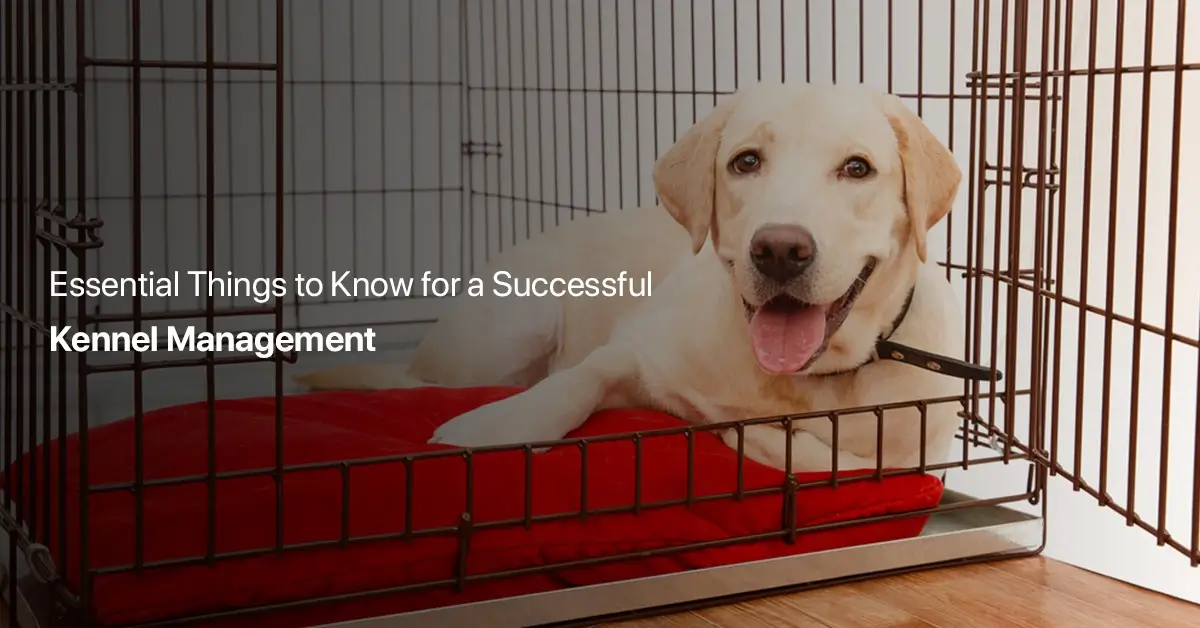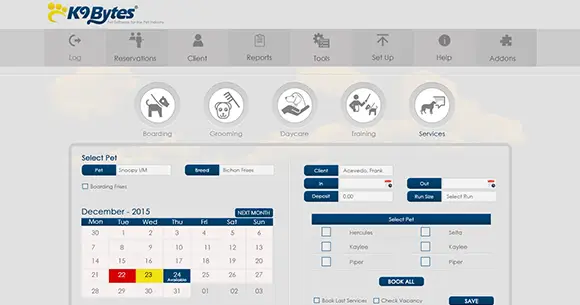Kennel management organizes and maintains every part of a kennel to give dogs the best care possible. It includes key areas such as cleanliness and sanitation, feeding and nutrition, health care, stress control, safety, record keeping, staff training, and environmental management. Each area is essential in keeping dogs healthy, comfortable, and secure while building trust with pet owners. When managed correctly, they work together to create a smooth kennel that ensures dogs are cared for with consistency, safety, and compassion.
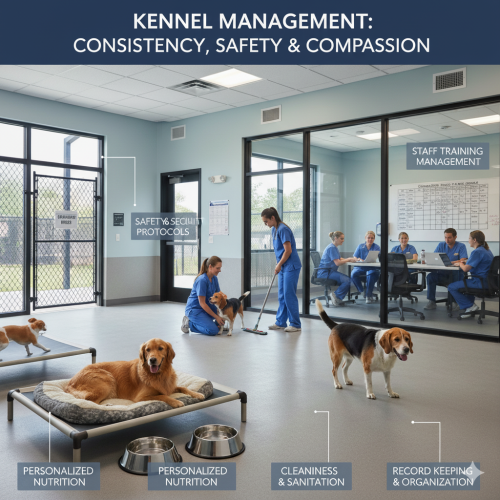
Managing a kennel is about more than just providing shelter for dogs. It requires structure, organization, and attention to every detail that impacts a dog’s health and well-being. Kennel management is the system that keeps everything running smoothly, from feeding routines and health checks to sanitation, record keeping, and staff training.
In this blog, we will explore kennel management and the most essential areas that make it successful.
What Does Kennel Management Mean?
Kennel management refers to organizing, maintaining, and operating every aspect of a kennel to ensure that dogs are cared for in the best possible way. It is not only a key part of daily dog care but also plays a vital role in the success of a kennel business. The focus is not just on profits or business growth, but on how smoothly the kennel operates each day to meet the needs of the dogs living there.
Good kennel management covers all aspects of daily care. It includes a Proper kennel business management plan, cleaning and disinfecting the space, ensuring dogs receive proper food and clean water, monitoring health conditions, and keeping records of each dog’s needs. It also requires safety systems to protect dogs from harm and trained staff who can handle tasks consistently and responsibly.
Simply put, kennel management is the backbone of dog care inside a kennel. Without strong management, even the most advanced or well-equipped kennel business would struggle to create a healthy and safe environment for dogs.
Key Things That Shape Kennel Management
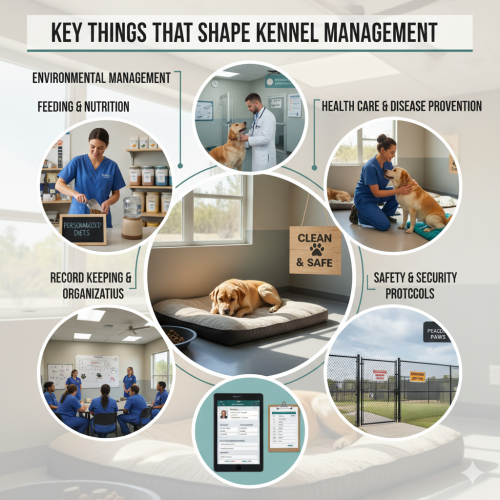
To fully understand kennel management, we need to examine the areas that influence how well a kennel operates. Each area contributes to the overall success of the kennel and ensures that dogs receive the highest-quality care possible.
1. Cleanliness and Sanitation in Kennels
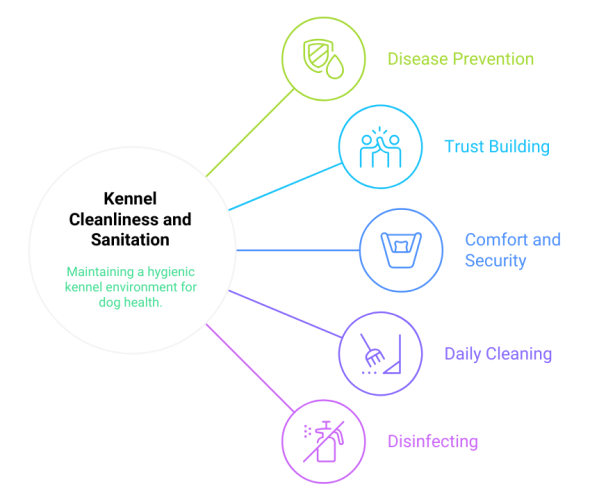
Cleanliness means removing dirt, waste, and odors from the kennel environment, while sanitation involves disinfecting surfaces to destroy harmful germs. Together, they create a safe and hygienic space for dogs.
In kennel management, cleanliness is crucial for preventing disease and infection. Regularly cleaned kennels reduce the chances of dogs contracting illnesses from each other.
When cleanliness and sanitation are taken seriously, kennels earn the trust of pet owners and provide a healthier environment where dogs feel more comfortable and secure.
- Daily cleaning prevents bacteria and odor buildup.
- Disinfecting food bowls and bedding lowers the risk of infection.
- A clean kennel reduces stress and improves comfort for dogs.
2. Feeding and Nutrition Management
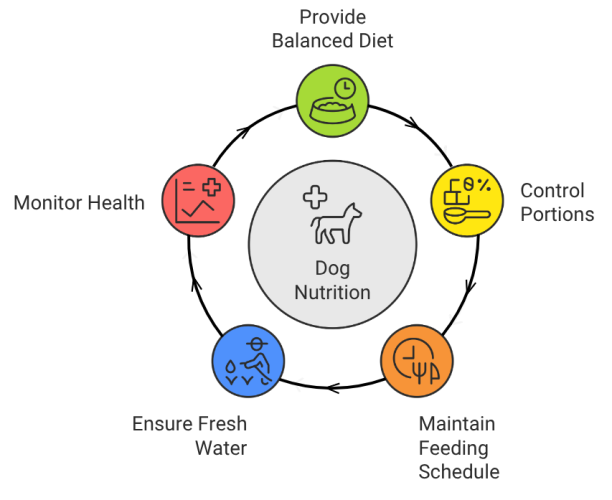
Feeding management involves providing dogs with meals that match their age, breed, and health needs. It also means controlling portions, creating schedules, and ensuring constant access to clean water.
Its role in kennel management is maintaining dogs’ health, energy, and growth. Dogs with balanced diets are less likely to suffer from obesity, digestive issues, or nutritional deficiencies.
Successful kennel management depends on good nutrition because healthy, well-fed dogs are more active, happy, and easier to care for.
- Feeding schedules build consistency and routine.
- Portion control prevents obesity and health problems.
- Fresh food and clean water support overall well-being.
3. Health Care and Disease Prevention
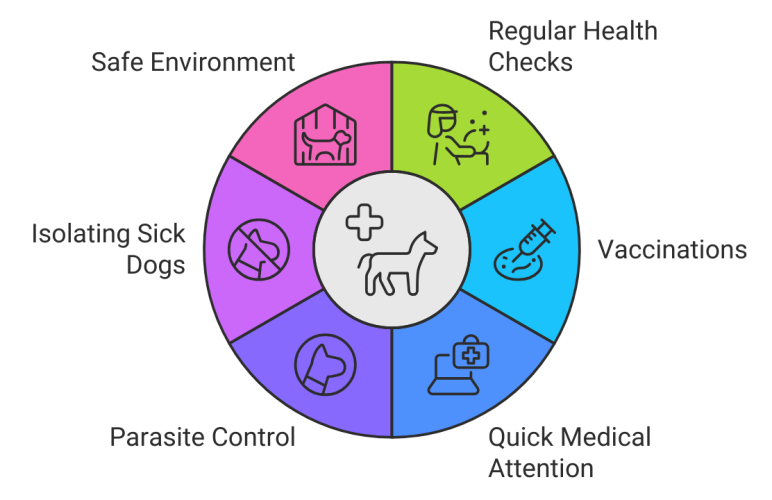
Health care in kennels means regular health checks, vaccinations, and quick medical attention when needed. Disease prevention includes parasite control, separating sick dogs, and keeping the environment safe.
This area of kennel management ensures that diseases do not spread quickly, especially since dogs live close together.
Kennels that manage health properly gain owners’ confidence, knowing their pets are safe and well-cared for.
- Vaccinations reduce the risks of common illnesses.
- Routine health checks catch problems early.
- Isolating sick dogs stops infections from spreading.
4. Comfort and Stress Control in Kennels
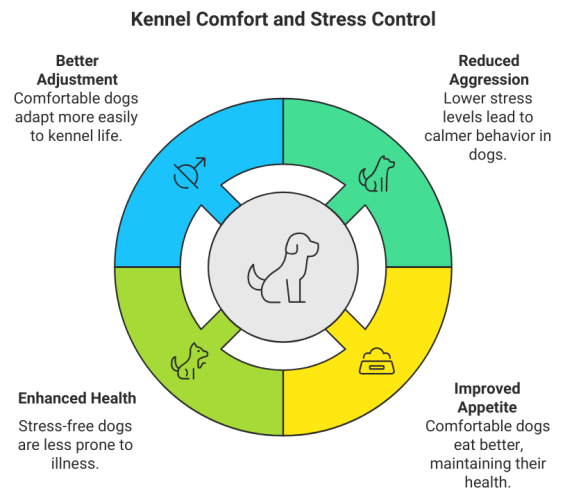
Comfort means giving dogs safe resting spaces, soft bedding, and a peaceful environment. Stress control reduces loud noises, maintains routines, and provides positive interactions.
The role of comfort and stress management in kennel care is to keep dogs relaxed. Stress can lead to aggression, loss of appetite, or health problems, so lowering it is essential.
When dogs feel comfortable, they adjust better to kennel life and remain healthier and happier throughout their stay.
- Comfortable bedding ensures proper rest.
- Quiet surroundings reduce anxiety and barking.
- Gentle handling builds trust between dogs and staff.
5. Safety and Security Protocols
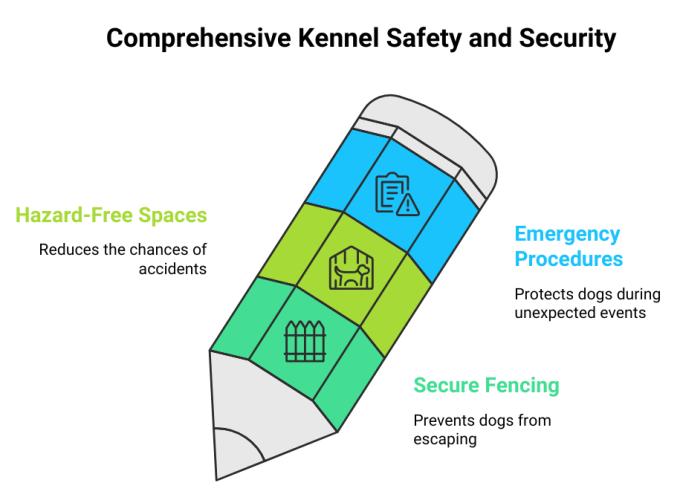
Safety and security are about protecting dogs from accidents, injuries, and escapes. This includes secure fencing, locked gates, and safe storage for cleaning chemicals and equipment.
In kennel management, safety ensures dogs remain protected at all times, while security reassures owners that their pets are in good hands.
A successful kennel focuses on safety to minimize risks and emergencies.
- Secure fencing prevents dogs from escaping.
- Hazard-free spaces reduce the chances of accidents.
- Emergency procedures protect dogs during unexpected events.
6. Record Keeping and Organization
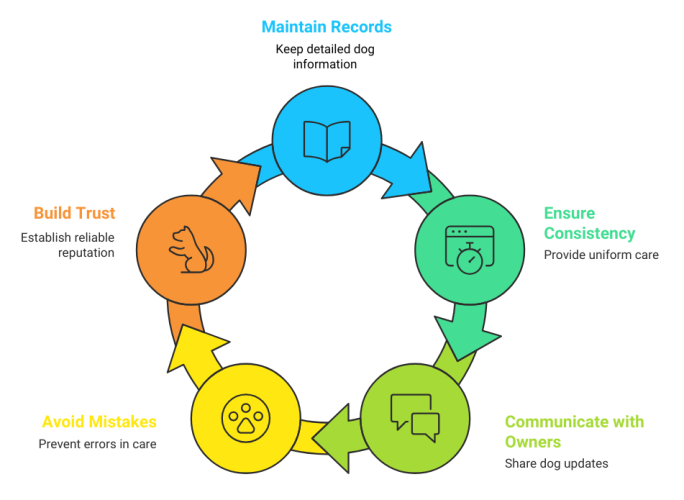
Record keeping involves maintaining precise details about each dog, including feeding schedules, medical history, vaccinations, and behavior notes.
In kennel management, the organization ensures that staff provide consistent and accurate care. Good records also make communicating with pet owners about their dogs easier.
When records are properly maintained, kennels avoid mistakes and create a professional, trustworthy system.
- Feeding logs helps staff stay consistent.
- Medical records track vaccinations and treatments.
- Behavior notes help customize care for each dog.
7. Staff Training and Scheduling
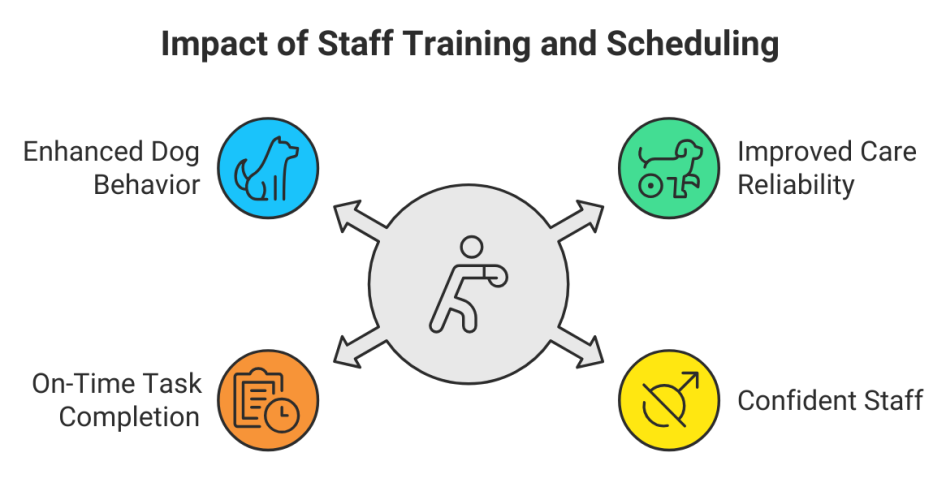
Staff training ensures workers know how to feed, clean, handle dogs, and respond to emergencies. Scheduling organizes tasks so that nothing is overlooked.
This area’s role in kennel management is to make care more reliable. Trained staff work confidently, and scheduling ensures tasks are completed on time.
When kennels invest in staff, the level of care improves, and both dogs and owners benefit.
- Training develops staff skills and knowledge.
- Scheduling prevents confusion and missed tasks.
- Consistent routines improve dog behavior and comfort.
8. Environmental Management
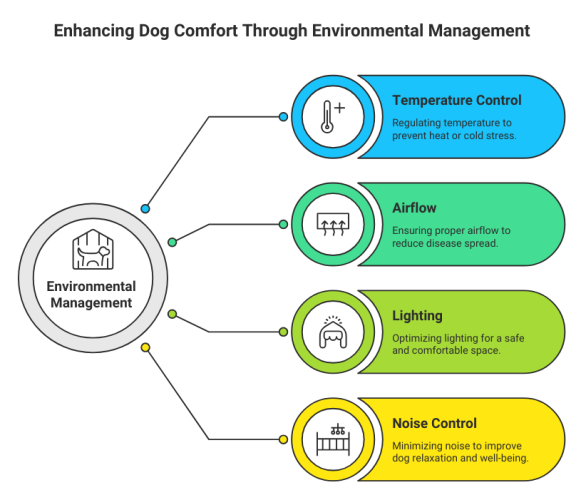
Environmental management includes controlling temperature, airflow, lighting, and noise inside the kennel. It ensures that the physical space is safe and comfortable.
This area protects dogs from environmental stress and supports their daily comfort in kennel management.
A well-managed environment helps dogs relax, prevents health issues, and creates a welcoming kennel.
- Proper airflow reduces the spread of disease.
- Temperature control protects dogs from heat or cold stress.
- Calm, quiet spaces improve overall well-being.
Key Areas of Kennel Management
Kennel management involves several core areas that ensure dogs remain healthy, safe, and comfortable. Kennels can run smoothly while building trust with pet owners by focusing on cleanliness, nutrition, health care, safety, records, staff, and the environment.
|
Area |
Meaning |
Why It Matters for Kennel Management |
|---|---|---|
|
Cleanliness & Sanitation |
Remove dirt and odors, and disinfect to kill germs. |
Prevents illness, reduces stress, and creates a hygienic, trustworthy dog space. |
|
Feeding & Nutrition |
Providing balanced meals, portion control, and clean water. |
Supports health, energy, and growth while preventing obesity and digestive issues. |
|
Health Care & Prevention |
Routine checks, vaccinations, and isolating sick dogs. |
Stops diseases from spreading and assures pet owners their dogs are well cared for. |
|
Comfort & Stress Control |
Soft bedding, quiet areas, and gentle handling. |
Reduces anxiety, improves behavior, and helps dogs adapt better to kennel life. |
|
Safety & Security |
Safe fencing, hazard-free spaces, and emergency protocols. |
Protects dogs from escapes, injuries, or accidents, ensuring a reliable and secure kennel. |
|
Record Keeping |
Tracking food, medical history, and behavior notes. |
Ensures consistent care, avoids mistakes, and communicates professionally with pet owners. |
|
Staff & Scheduling |
Training workers and organizing daily tasks. |
Improves reliability, consistency, and overall quality of care for dogs and owners. |
|
Environmental Management |
Managing temperature, airflow, lighting, and noise. |
Creates a comfortable space, prevents stress, and lowers risks of illness in the kennel environment. |
Final Thoughts
Kennel management is not about running a business but providing dogs the highest standard of care. From sanitation and nutrition to safety, staff training, and environmental control, every area works together to create a kennel where dogs are healthy, comfortable, and secure.
When these key areas are managed carefully, kennels become places of trust and reliability, ensuring every dog receives the love and attention it deserves.
FAQs
1. What education do you need to be a kennel manager?
Discover everything about being a kennel manager, including key skills and salary insights, in our complete guide.
2. Is working at a kennel hard?
Yes, it can be demanding, but software and sound systems make tasks more manageable.
3. Who runs a kennel?
A kennel is usually managed by a manager or owner overseeing daily care and staff.
4. How long does it take to kennel a dog?
Check-in takes only minutes, but full adjustment varies. As explained in What Is Kennel Training? Puppies may adapt in 1–2 weeks, while adult or anxious dogs may need several weeks to feel comfortable.
5. How to be a good kennel manager?
Focus on cleanliness, health, organization, and use tools like software to streamline care.
6. What makes kennel management successful overall?
Strong focus on care, safety, and organization ensures healthy and happy dogs.

